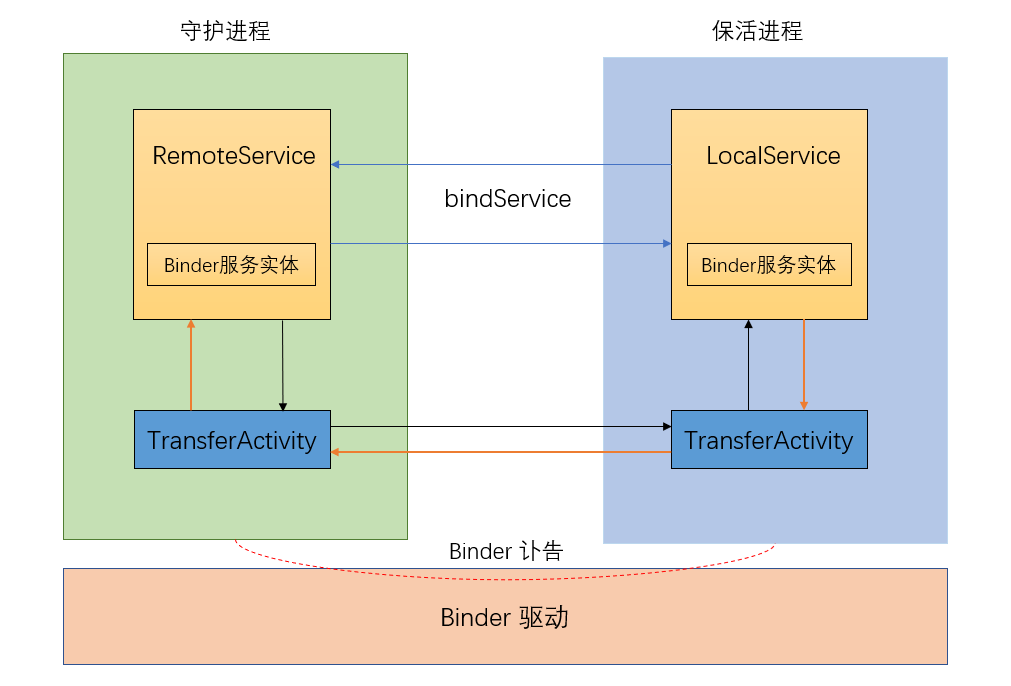虽然我也觉得强行保活应用挺不厚道的,但是没办法,为了完成需求。
一开始尝试的方案是 Android 5.0 后系统提供的 JobScheduler,能够预先设置条件,达到条件时自动启动 JobService,在 Android 8.0 以下都能很愉快的使用。但是在华为的 Android 8.0 上,当应用被杀后,JobService 就不能被系统调用了。
于是采取了双进程服务绑定方式,实现了应用保活功能。
直接看原理图:

原理就是利用 Binder 的讣告机制,如果 Service Binder 实体的进程被杀,系统会向 Client 发送讣告,这个时机就是保活的空子了。所以可以通过两个进程启动两个 Binder 服务,互为 C/S,一旦一个进程挂掉,另一个进程就会收到 Binder 讣告,这时可以拉起另一个进程。
那么图中两个进程中的 TransferActivity 是干什么用的 ,这个在后面再说。
这里我写了两个应用,一个是 AIDLServer,相当于服务端;一个是 AIDLClient,相当于客户端。而两个进程之间的通信采用 AIDL 方式。
1
2
3
4
5
6
7
8
9
10
11
12
|
package com.wuzy.aidlserver;
interface IMyAidlInterface {
void bindSuccess();
void unbind();
}
|
注意两个应用的 AIDL 文件必须一致,包括包名。
然后,编写两个 binder 实体服务 RemoteService 、LocalService,主要代码如下:
1
2
3
4
5
6
7
8
9
10
11
12
13
14
15
16
17
18
19
20
21
22
23
24
25
26
27
28
29
30
31
32
33
34
35
36
37
38
39
40
41
42
43
44
45
46
47
48
49
50
51
52
53
54
55
56
57
58
59
60
61
62
| public class RemoteService extends Service {
private static final String TAG = "RemoteService";
@Override
public void onCreate() {
super.onCreate();
Log.e(TAG, "onCreate: 创建 RemoteService");
bindLocalService();
}
@Override
public IBinder onBind(Intent intent) {
return stub;
}
private IMyAidlInterface.Stub stub = new IMyAidlInterface.Stub() {
@Override
public void bindSuccess() throws RemoteException {
Log.e(TAG, "bindSuccess: LocalService 绑定 RemoteService 成功");
}
@Override
public void unbind() throws RemoteException {
Log.e(TAG, "unbind: 此处解除 RemoteService 与 LocalService 的绑定");
getApplicationContext().unbindService(connection);
}
};
private void bindLocalService() {
Intent intent = new Intent();
intent.setComponent(new ComponentName("com.wuzy.aidlclient", "com.wuzy.aidlclient.LocalService"));
if (!getApplicationContext().bindService(intent, connection, Context.BIND_AUTO_CREATE)) {
Log.e(TAG, "bindLocalService: 绑定 LocalService 失败");
stopSelf();
}
}
private ServiceConnection connection = new ServiceConnection() {
@Override
public void onServiceConnected(ComponentName name, IBinder service) {
}
@Override
public void onServiceDisconnected(ComponentName name) {
createTransferActivity();
}
};
private void createTransferActivity() {
Intent intent = new Intent(this, TransferActivity.class);
intent.setAction(TransferActivity.ACTION_FROM_SELF);
intent.setFlags(Intent.FLAG_ACTIVITY_NEW_TASK);
startActivity(intent);
}
}
|
1
2
3
4
5
6
7
8
9
10
11
12
13
14
15
16
17
18
19
20
21
22
23
24
25
26
27
28
29
30
31
32
33
34
35
36
37
38
39
40
41
42
43
44
45
46
47
48
49
50
51
52
53
54
55
56
57
58
59
60
| public class LocalService extends Service {
private static final String TAG = "LocalService";
@Override
public void onCreate() {
super.onCreate();
Log.e(TAG, "onCreate: 创建 LocalService");
bindRemoteService();
}
@Override
public IBinder onBind(Intent intent) {
Log.e(TAG, "onBind: 绑定 LocalService");
return stub;
}
private IMyAidlInterface.Stub stub = new IMyAidlInterface.Stub() {
@Override
public void bindSuccess() throws RemoteException {
Log.e(TAG, "bindSuccess: RemoteService 绑定 LocalService 成功");
}
@Override
public void unbind() throws RemoteException {
getApplicationContext().unbindService(connection);
}
};
private ServiceConnection connection = new ServiceConnection() {
@Override
public void onServiceConnected(ComponentName name, IBinder service) {
}
@Override
public void onServiceDisconnected(ComponentName name) {
createTransferActivity();
}
};
private void createTransferActivity() {
Intent intent = new Intent(this, TransferActivity.class);
intent.setAction(TransferActivity.ACTION_FROM_SELF);
intent.setFlags(Intent.FLAG_ACTIVITY_NEW_TASK);
startActivity(intent);
}
private void bindRemoteService() {
Intent intent = new Intent();
intent.setComponent(new ComponentName("com.wuzy.aidlserver", "com.wuzy.aidlserver.RemoteService"));
if (!getApplicationContext().bindService(intent, connection, Context.BIND_AUTO_CREATE)) {
Log.e(TAG, "bindRemoteService: 绑定 RemoteService 失败");
stopSelf();
}
}
}
|
在 onCreate 的时候相互绑定,并在 onServiceDisconnected 收到讣告的时候,重新启动服务绑定彼此即可。
但是我在系统是 8.0 的华为机器上是无效的,也就是当 LocalService 所在进程被杀后,RemoteService 无法启动LocalService,反过来也是如此。
所以,这里只能采取 “曲线救国” 的方式。通过 TransferActivity 中转下,先启动守护进程的 TransferActivity,再从守护进程的 TransferActivity 中启动保活进程的 TransferActivity,这是没有问题的,再从保活进程的 TransferActivity 中启动 LocalService,重新绑定服务即可,反过来也是一样的。当然,TransferActivity 要用户无感知,不然会很突兀,所以这里的 TransferActivity 都是 1 个像素,做完任务及时销毁即可。
TransferActivity 的代码就不贴了,具体可以去 GitHub 了解。
这种方式用来保活一般是没有问题的,因为 Binder 讣告是系统中 Binder 框架自带的,除非一次性杀了两个进程,那就没辙了。
最后,一般保活的目的是为了做某项任务,所以,任务完成后应该结束保活功能,不然老是占着内存确实挺不厚道的。
